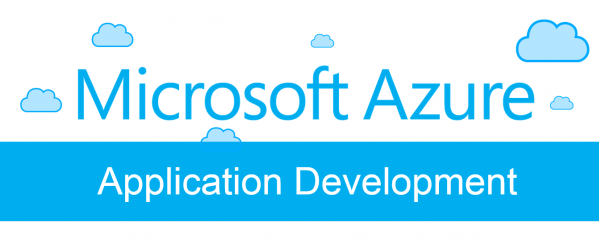Nowadays, the pool of companies continues to have serious issues regarding moving applications to the cloud with security. However, the doubts concerning the network security, obtainability and potential lost time are key decisions that sometimes paralyze current technology even as for the growing companies. However, the entire Microsoft Azure-based on a cloud-leading solution or partial cloud architecture, formerly known as Windows Azure, and the public cloud computing platforms of the Microsoft. Since it is world widely known as a leading credential where users can avail multiple options, on account of this more organizations are heading towards Azure certification courses and tends their experts to enroll for Azure developer certification so that they can maintain the stability in the market.

What is Microsoft Azure Development?
Concerning the Microsoft Azure Development, it is determined that Microsoft has provided a growing global data center network to create Azure, a cloud-based hub that lets you create, deploy, and manage services and applications anywhere in the system respectively. However, Azure allows an individual to add cloud functionality to the existing network as a service model, PaaS, through the platform or to provide Microsoft with all the IT and network requirements with IaaS (infrastructure as a service). One or the other way, you get secure and reliable access to your cloud-hosted data, and one based on Microsoft’s established structural design. With a convenient and easy to manage platform, Azure offers a growing range of products and services designed to meet every single need of a person. One of the features that make Azure exclusive among the rest cloud solutions is its integration with Visual Studio, which allows for a smooth flow of development from project implementation to application in addition to resource supervision.
Azure Productivity Tools
Regarding the Azure productivity tools, let’s take a look at some of the general productivity enhancements tools that let one use Windows Azure, which simplifies cloud distribution and manages the applications accordingly. The following are the 10 significant tools for integrating Azure directly into your development environment.
2015 Cloud Explorers for Visual Studio is a new set considering as of Microsoft tools that allow searching Windows Azure resources by name, type or group of resources in a straight line from the Visual Studio I.D.E. However, Cloud Explorer shows the resources, analytics, and source development steps that are supposed to be available, and has a deep connection with Azure’s predictive resource and group management portal.
Azure-Ping: This is a free extension tool of Windows Azure for monitoring, which is created by Igor-Papirov of Paraleap Technologies. However, Azure Ping knowing as a local Windows service that maintains tabs for resources or databases hosted by the Azure, and also specifies the URL’s which are assigned to the service. It has simple log features built-in and can add own notifications via the Apache-log-4.net extension.
Cloud Combine: This tool makes it easy for browsing, downloading, transferring and allocating files between cloud storage services, including Windows Azure, AWS, and Google Cloud. Though, Cloud Combine makes it easy to connect to all the cloud services and storage management through a simple, explorer-like interface.
SQL Database Migration Wizard: This tool is still on working and has been developed to help in order to migrate SQL-Server 2005, 2008, 2012 and 2014 databases to an Azure-SQL database using dot NET Framework 3.5 and 4.5. SQL – Azure Migration Wizard that incorporates Migration Update and Analysis in order to identify and resolve potential issues before migrating is enabled.
Azure Blob Studio 2011: This is an older tool that allows managing Azure Blob storage, including creating and deleting containers, editing management, recovering URIs and recovering, backward object meta-data, etc. However, it is not estimated that if it works in Visual Studio versions later than 2010, but third-party tools are also available.
Light-Switch Azure: Since these tables are designed to allow Light-Switch developers to use Azure table storage as a built-in data source for the Light-Switch process. However, Light-Switch Azure Tables let a person connect to an existing memory, easily create new charts, define custom sections and keys, and create W.C.F- R.I.Services. Though this is another older tool in Visual Studio-2010, it’s worth checking if someone working hard on Light-Switch.
Microsoft Azure Storage Connected Service: Another new Microsoft tool that provides formatting tools to configure Azure storage services, use code generation services, and create, manage, or consume containers, and objects. It provides a great guide to getting started with Storage Memory and Visual Studio to guide through Microsoft Azure Storage Connection.
Graph Engine VS-Extension: This is a Microsoft research S.D.K developed tool using Graph Engine, although not specifically intended for Azure, VS-Extension Graph Engine supports direct distribution in Visual Studio- 2012, 2013 and 2015 for Azure.
.NET Database: It provides complete data management and development tools right in Visual Studio Project Explorer. However, SQL – Azure is one of 22 data sources supported in the database. .NET provides browsers, spreadsheets, and data browsers, and it supports Visual Studio – 2015, 2013, 2012, 2010 and 2008.
Ignite Azure-Db Write-Bolt: This similarly combines some interesting techniques, it’s the locked Storm-Apache that lets people write real-time data feeds in SQL-Azure. The storm is a real-time distributed and open-source computer while handles inlet streams and create new production flows.
Azure Competition
Currently, Microsoft Azure is considering as a leading provider of large-scale cloud services, and other major vendors incorporated with Google Cloud Platform (G.C.P), Amazon Web Services (A.W.S), and IBM respectively. There is presently no calibration between cloud services and features, which means that no cloud service offers exactly the same facility in accurately the same way as consuming the same integration or API. Though, this makes it difficult for businesses in order to hire many cloud companies along with Azure certification courses training to enforce the multiple cloud policies, although third-party cloud technology can alleviate some of these issues.
